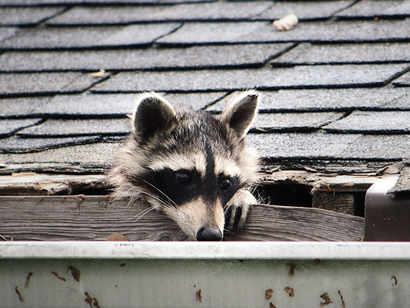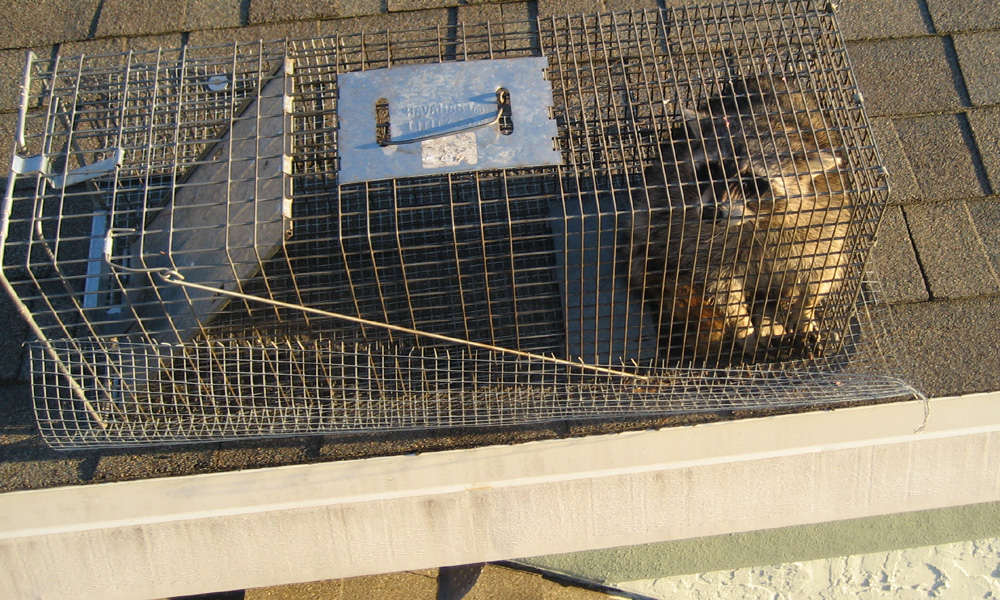- USA Wildlife Removal Education Guide and Resources
Raccoon on the Roof

Removing A Raccoon On The Roof
Climbing is one of the natural instincts for the raccoon, and with paws and limbs designed for scrambling up a variety of surfaces, it is no surprise that raccoons are often a problem that can appear on the roof of many buildings. Whether it is climbing up drainpipes or walls that offer small areas where they can grip, or they are getting on to the roof from adjacent trees, it is important to remove the raccoons from the roof as soon as possible. There are many different situations that can arise from having raccoons on the roof, so look to act quickly and prevent the raccoons from causing more serious problems.
Why Do Raccoons Make Their Way On To The Roof Of A Domestic Property?
One of the natural survival instincts of the raccoon is to find a safe place above ground level, so they will often first find their way on to the roof if they are scared by another animal. If they are returning to the roof time and again, this will either mean that they are in the attic and are going in and out of their nest, or they are finding insects living in the cracks under the roof tiles. In most cases, and particularly of concern if they are on a domestic roof, the raccoons will have found a nest, and during the mating season this will mean you have baby raccoons to deal with as well as the parent.
Is The Raccoon Nesting In The Attic?
When it comes to trying to identify that you have a raccoon problem, there are certain precautions to take before stepping into the attic, and this includes wearing long sleeved thick clothing along with a breathing mask and goggles. In most cases if there are raccoons in the attic it will usually be quite messy, but the animals themselves will usually be trying to conceal themselves in the corner if they are present. Be careful, as some animals may attack unexpectedly if they are startled or feel as though they have no other options, and look for signs such as long feces with visible pieces of berry, which will help you identify whether or not it is a raccoon.
Bringing A Raccoon Down To Ground Level
In some situations, you may hear the tread of a raccoon on the roof, but if it doesn't seem to want to find an escape route when you go outside to look at it, you may have to think about manually removing the animal from the roof. The best tool in this case is a snare pole, which is a pole with a loop around it that can be used to move the animal without direct contact. In smaller roof spaces, you may also be able to get close enough to throw a basket or box over the animal if it has nowhere else to escape to, but be very careful when using this type of approach to remove the raccoon.
Trapping Raccoons That Are Regularly On The Roof
Whether the raccoons are getting on the roof or actually using it as a route to the attic, trapping is an important way of dealing with the issue, and cage traps are the most common approach to catching these animals. If you can find the hole that the raccoons are using to get in and out, one good approach is to place a cage trap over that hole, or to affix it in a nearby location and create a tunnel from chicken wire to guide the animal into the trap.
Dealing With Raccoons In The Attic
Once you have trapped the raccoons, it is very important that you also search the attic for the baby raccoons, after taking the right precautions of wearing long sleeved clothing and thick gloves, along with a mask and goggles. If you are relocating the adult raccoon, it is best to do it with the baby raccoons too, and some of the best trappers will catch the babies while the mother is out, and then use them to bait the trap so that all of the raccoons are in the trap together. It is also important to thoroughly clean and disinfect the attic once you have removed the raccoons.
Preventing Raccoons From Getting To The Roof In The Future
Along with sealing any holes in the roof that were allowing the raccoons on to the attic, it is also important that you check the tiles on the roof haven't been damaged or loosened by the animals. If raccoons were getting on to the roof from the surrounding trees, make sure that the branches are trimmed back so it isn't possible to jump on to the roof, while in some cases the tree may need to be entirely removed. While stopping raccoons from climbing on to the roof up the wall or drainpipe is very difficult, making sure all vents and soffits are in good condition should help prevent them from getting in the attic.

Go back to the main Raccoon Removal page for more information about raccoon on the roof, and what types of noises or sounds they make. Do you hear the raccoon on the roof during the night or the day?

